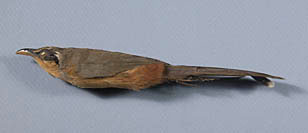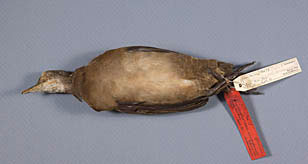William Tilman Elkinton (1860-1933)

William T. Elkinton with wife, Eleanor.
Image courtesy of Lora E. McFall.
William T. Elkinton’s role as a major donor to the Academy’s ornithology collection seems to be due to his close relationship with his wife, Eleanor’s, family, the Rhoads. Elkinton, who headed the Philadelphia Quartz Company, joined his step-mother-in-law Beulah M. Rhoads to help fund a 1915 Academy expedition to Guatemala undertaken by his step-brother-in-law, Samuel N. Rhoads and the collector Earl L. Poole. Elkinton and Rhoads’ support helped the Academy add 810 Central American birds to its collection.
Like many other supporters of the Academy, Elkinton was a Quaker, a graduate of the prestigious Westtown Friends School and Haverford College. As a business executive, he was involved in the expansion of the modern chemical products industry. The Philadelphia Quartz Company, now known as the PQ Corporation, was founded in 1831 by William T. Elkinton’s grandfather, Joseph Elkinton. Known until 1888 as the Elkinton Company, the business produced candles and soap in a factory in South Philadelphia. In the mid-1840s, Joseph’s son, Thomas Elkinton, used soluble silicates, derived from quartz, to develop a synthetic detergent, a product that took off during the Civil War when the cessation of commerce with the South meant that essential components in soap production were no longer available in the North.

Lesser Ground Cuckoo
(Morrococcyx erythropygus macrourus)
ANSP 63742

Lesser Roadrunner
(Geococcyx velox pallidus)
ANSP 63745

Keel-billed Toucan
(Ramphastos sulfuratus brevicarinatus)
ANSP 63727, Paratype

Little Tinamou
(Crypturellus soui meserythrus)
ANSP 63613

Ferruginous Pygmy Owl
(Glaucidium brasilianum ridgwayi)
ANSP 63650

Tourquoise-browed Motmot
(Eumomota superciliosa sylvestris)
ANSP 64723, Holotype
After the Civil War, the company expanded its production to include fertilizers, fibers, adhesives, and other industrially manufactured goods using soluble silicates. By the time William T. Elkinton became president of the Philadelphia Quartz Company in 1907, the thriving business had long outgrown its original South Philadelphia location. Elkinton oversaw the construction of new manufacturing plants in Kansas City, St. Louis, Buffalo, and other locations throughout the country. After retiring from the presidency in 1929, he became chairman of the Board, a position he held until his death four years later.
Elkinton funded Samuel Nicholson Rhoads and Earl Lincoln Poole’s collecting trip to Guatemala in early 1915. Most of the fieldwork, which obtained 810 study skins, was conducted in central southern Guatemala, an area now almost completely devoid of the pristine environment they would have encountered. It is now planted with coffee and used as grazing land for cattle. The collection is composed of many of the common locally breeding birds along with several wintering birds that breed in North America. Rhoads and Poole discovered six new species on this trip; Berylline Hummingbird, Amazilia beryllina motaguae (ANSP 131661), Buff-breasted Flycatcher, Empidonax fulvifrons fusciceps (121441), Turquoise-browed Motmot, Eumomota superciliosa sylvestris (64723), Lesser Roadrunner, Geococcyx velox pallidus (63745), Keel-billed Toucan, Ramphastos sulfuratus brevicarinatus (63727), and Keel-billed Toucan, R. s. intermedius (63729). Collecting and preparing birds in the field is difficult business and there are certain species that can be particularly hard to collect, as they are visually quite cryptic, remain silent for long periods, or are in very low density. Examples of such taxa collected by Rhoads and Poole include; Little Tinamou, Crypturellus soui (63612-3), Ferruginous Pygmy Owl, Glaucidium brasilianum (63646-50), Roufous Mourner, Rhytipterna holerythra (64023), and Lesser Ground Cuckoo, Morococcyx erythropygus macrourus (63741-3).
Although there is little in Academy records about Elkinton’s involvement with the institution, in 1930 he was nominated for membership by Academy President Charles M.B. Cadwalader and James A.G. Rehn, Entomology Curator and an important bird collector. The following year, he was listed as an annual member. While his allegiance to the Academy seems primarily familial, Elkinton’s becoming a member through high level sponsorship suggests more than a passing interest. Further research in the Academy’s uncatalogued papers will be needed to determine what further role he played in scientific research.
Proud Decendants of William Tilman Elkinton
Elizabeth Elkinton Barr and Lora Elkinton MacFall